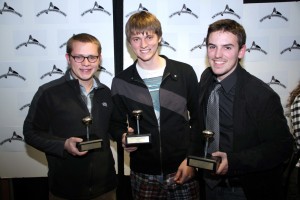
One crew. One semester. One goal: create a film worthy of first place for the Golden Doorknob Award.
For this spring’s Skip Landen Golden Doorknob Award competition, film students from the Roy H. Park School of Communications had to create five-minute videos presenting the most imaginative way to kill someone with a doorknob. A total of 26 films were submitted to the competition. The winners were honored at the award ceremony April 29.
Senior Sam Patton, a two-time first-prize Doorknob winner and director of this year’s winning film “Grogg,” said the inspiration for the storyline came immediately following the 2010 competition.
“I started with the notion that the inventor of fire crawled out of a cave announcing to the world that he invented fire,” he said. “It floated around in the back of my head for awhile, and then I wanted to tell the story of the guy who invented the doorknob.”
The film is set in prehistoric times and does not use any dialogue to tell the story. Patton said “Grogg” is similar to a Pixar short that plays off the biblical tale of Cain and Able to address the competition’s prompt.
Main character Grogg is a scrawny, weak caveman who is constantly nagged by his mother and stereotypical caveman brother. One day, he wishes he could shut them out, and therefore comes up with the idea of the doorknob. His invention makes Grogg a hero among his contemporaries. So out of jealousy, Grogg’s brother kills him and claims the invention as his own.
The creative brain behind Patton’s vision was junior Wyatt Cain, who was busy scripting away on the West Coast while abroad in Los Angeles. Patton said King had the talent and humor to create his vision in an engaging story format.
“He came back with the first draft of the script, and I couldn’t have been more excited,” he said. “At the same time that it was my ideas fully fleshed out, it was jokes and a world that I hadn’t even dreamed up. He had really done what I wanted justice, and then some.”
Freshman Mike Bellmonte, producer of “Grogg,” was responsible for translating this story onto the big screen. Patton picked Bellmonte up at the beginning of the year when he was looking for whatever hands-on film experience he could find on campus.
“I was the lowly PA who was willing to work on any show I could,” Bellmonte said. “But Sam allowed me to move up through ranks really quickly. I can’t think of anyone else who let freshmen produce.”
Bellmonte said he played many roles in the production of this film, including overseeing commission and organizing the crew to designing the cave set and assisting with lighting. He said the project was ambitious because a period piece of prehistoric times involves a lot of shooting.
Patton said the self-made cave setting called for more controlled temperatures and lighting. And between scouting out local locations and prehistoric costuming, and building their own cave set, he also said it took weeks before the crew could begin filming.
These factors made it easier for sophomore Jesse Dacri, director of photography and editor of “Grogg,” to visually tell the story. While operating the Canon dSLR, Dacri said he used specific lighting and close-up shots in the video to convey the characters’ emotions.
“We had to shoot it with no dialogue so we had to make sure everybody carried what the audience was supposed to feel,” he said. “The script was all description, so we just had [the actors] yell and rely on their facial expressions to tell [the audience] what they were thinking.”
Along with the challenge of not using dialogue, Patton said having a seven-page script for a five-minute movie was also difficult. He said cutting the film from its original seven and a half minutes took away from some of the defined character relations.
“For running time, the one-page-one-minute screen time rule is surprisingly accurate,” he said. “The mother and two sons’ relationships don’t really come across in a five-minute cut.”
To compensate for the absent relationships, Patton said he scored the film with free-loop percussions and songs from bands like Queen to evoke the right emotions. He said it was the first time he shot a film worthy of pop music.
“If you pick a popular song and footage sucks, it’s going to highlight how bad your footage is,” he said. “This was the first thing that I’ve ever been a part of shooting that stood up to the music we were putting behind it, which felt really good.”
Patton said his biggest achievement for this film was not wasting anyone’s time and creating an environment that made everyone eager to work on the set. He said without the team collaboration the film would have been nearly impossible to produce.
“We realized that if any piece of this puzzle hadn’t come together the way it had, the film wouldn’t have happened,” he said. “We had to keep moving, keep working, keep making good stuff day after day. That atmosphere stayed with the whole team and almost never left, and that’s unheard of on a set.”
With all the time dedicated to filming and acting, and the money spent out of pocket on costumes and props to bring this period piece to life, Bellmonte said the grand-prize of $2,000 helped the crew break even. But he also said receiving the Doorknob Award was an honor itself.
“It was more about the pride that we won first place,” he said. “It wasn’t about the money.”




